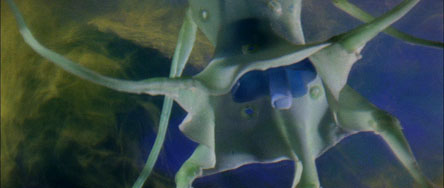Dogora
| ||||||||||||||||||||||||||||||||||||||||||||||||||||||||||||||||||||||||||||||||||||||||||||||||||||||||||||
Dogora (ドゴラ) is a mutant space cell kaiju created by Toho that first appeared in the 1964 film, Dogora.
Appearance
Dogora initially resembles a bluish amoeba-like blob. Dogora can take the form of a bluish-green vapor, or even be invisible at times. After growing substantially from consuming carbon, Dogora takes the form of a colossal light green jellyfish with long thin tentacles, and an opening on its underside through which it can absorb sources of carbon. When Dogora is struck by missiles, it undergoes cell division and splits into countless smaller blob-like forms. When Dogora comes into contact with wasp venom, its body undergoes a chemical reaction that causes it to crystallize into hardened multicolored rocks.
Origins
According to Dr. Munakata, Dogora is a space cell that lived in the Earth's upper atmosphere. The cell was exposed to a huge cloud of radiation located in the atmosphere over Japan, causing it to mutate rapidly. The cell then began to require large amounts of carbon to sustain itself, and so descended to Earth to feed on carbon sources such as diamonds and coal.
History
Showa Series
Dogora

Dogora first appeared in space, feeding on radiation. It destroyed a television satellite, causing it to mutate further. It came to Earth and began eating diamonds and coal. A professor created a synthetic diamond, and Dogora was attracted to it. It melted the safe doors and ate the diamonds. It attacked a coal plant, and it was discovered that it feeds on carbon. Defense forces thought they detected Dogora in the sky over Kyushu, but it was a swarm of bees. The bees flew into a cloud, and dozens of multiple-colored rocks fell out. Dogora was detected again as it attacked Fukuoka, now taking the form of a colossal jellyfish-like creature with long tentacles. Dogora began to feed on coal and diamonds, but was confronted by the JSDF, who blew it to bits with their missiles, but not before hurling a bridge at the humans in an attempt to ward them off. The pieces of Dogora regrew into their own cells, and attacked again. It was discovered that Dogora was weak to wasp and bee venom, as it caused its cells to crystalize. The JSDF released large amounts of wasp venom onto the Dogoras, causing them to harden and die.
Godzilla Island
In one episode of Godzilla Island, Dogora appears as an evil spawn of the Xiliens.
Post-Millennium Series
GODZILLA: Monster Planet
A GODZILLA: Monster Planet timeline distributed at AnimeJapan 2017 mentions that Dogora attacked London in September 2002, causing 3.9 million deaths.[2]
Abilities
- Dogora can fly, even when carrying objects of extreme mass.
- Dogora has tentacles which it can use to attack or grasp objects, which it can then use to attack.
- Dogora's body has a corrosive effect.
- Dogora is able to work like a vacuum and suck up needed minerals if its body is divided.
- Each piece of Dogora will take on a life of its own and can grow into a mature Dogora.
Weakness
Bee and wasp venom is lethal to the Dogora and will cause their bodies to solidify.
Filmography
- Dogora (1964)
- Godzilla Island (TV 1997)
Video Games
- Godzilla: Monster of Monsters
- Godzilla: Heart-Pounding Monster Island!!
- Godzilla: Trading Battle
- Godzilla Generations
Godzilla: Monster of Monsters
Dogora appears in three different ways in this popular Godzilla game for the NES. It appears in its own hyperspace type, and can first be encountered on Earth. Dogora first appears in its classic, large jellyfish form in the stage's background, and doesn't attack.
Dogora's other two versions appear as smaller enemies in the stage. One version is dark purple while the other is a bright orange/yellow. The differences between the two colors dwell upon the damage they deal and the items they drop. Purple Dogora deal no damage and drop health power ups when they are destroyed. Orange Dogora deal a small amount of damage and drop energy power ups when destroyed. This is also the only time in the game that the energy power ups can be found.
Dogora in Godzilla: Monster of Monsters
Gallery
- Main article: Dogora/Gallery.
Roar
|
Trivia
- Dogora's roar was reused for Ultraman's 4th dimensional enemy, Bullton.
- For scenes of it in its full form, the Dogora prop was placed in a small vat of water and puppeteered by people holding wires. This gave it the impression of it floating like an airborne squid.
References
This is a list of references for Dogora. These citations are used to identify the reliable sources on which this article is based. These references appear inside articles in the form of superscript numbers, which look like this: [1]
|


